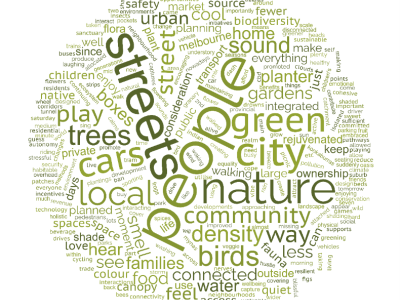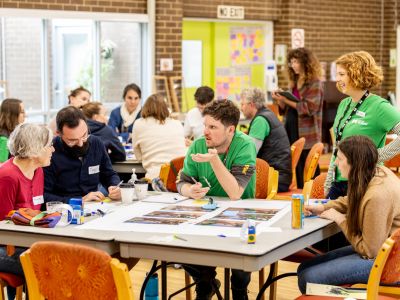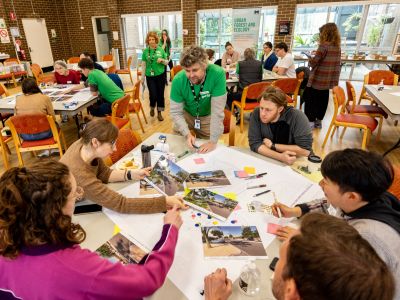2025
The conversation
The Urban Forest Precinct Plans are our street tree implementation guidelines that underpin our Urban Forest Strategy. They outline what is going to be planted where, when and why over the next ten years.
The urban forest is vital for the health and wellbeing of the city, it provides critical ecosystem services such as clean air, water filtration, shade, habitat and carbon sequestration. It also supports a connection to nature for people living in urban areas.
These plans are being renewed for each of our 10 urban forest precincts. We have been speaking to residents in each neighbourhood to help ensure the plans align with community values.
Gathering insights
We conducted community consultation to inform the North and West Melbourne Urban Forest Precinct Plan between February 2023 and June 2024.
During this time, we held multiple community pop up events, an online survey and a community workshop.
Community priorities, values and preferences directly informed the urban forest vision, character and priorities.
We then sought community feedback on the draft North and West Melbourne Urban Forest Precinct Plan 2025-2035 (PDF 3.17 MB) through a survey on Participate Melbourne. This survey was open from 1 to 30 August 2025.
to the Participate Melbourne project page with the draft plan.
of the full draft plan.
with feedback on the draft plan.
These totals are in addition to earlier engagement in 2024 where:
- 63 people registered for the workshop
- 40 people attended the workshop or other in person engagement
- 151 people engaged through an online survey to inform the draft plan.
Over 200 community members of North and West Melbourne have so far been involved in the development of this plan.
What we heard
Community vision
When asked if this community vision captured hopes for North and West Melbourne:
- 61% of survey participants agreed or strongly agreed.
- 17% of survey participants disagreed.
- 17% of survey participants were neutral (neither agree nor disagreed).
Those who disagreed wanted a more holistic plan that not only covers street tree planting but also broader greening initiatives, like understorey greening on median strips.
Community priority areas
Community workshop participants identified areas for improvement in North and West Melbourne. When asked how satisfied survey participants were with these areas:
- 48% agreed or strongly agreed.
- 35% disagreed or strongly disagreed.
- 17% were neutral (neither agreed nor disagreed).
Survey participants who disagreed wanted a stronger focus on homeowners greening private property and biodiversity corridors.
Street character
The draft plans include a map of street planting types and some recommendations for neighbourhood character in North and West Melbourne:
- 68% of survey participants agreed or strongly agreed.
- 14% of survey participants disagreed or strongly disagreed.
- 18% of survey participants were neutral (neither agreed nor disagreed).
Those who disagreed wanted to understand the implications of powerlines and tree planting.
Biosecurity
The draft plans outline an approach of replacing certain plant species in some areas to create 'species breaks', which would protect significant populations of high-threat species in North and West Melbourne:
- 61% of survey participants agreed or strongly agreed.
- 17% of survey participants disagreed or strongly disagreed.
- 22% of survey participants were neutral (neither agreed nor disagreed).
Those who disagreed disliked granitic gravel as the base of tree plots and wanted more fruit trees. There was concern expressed about trees causing negative health impacts.
Street prioritisation
The draft plans outlined which streets will be prioritised for planting over the next ten years in North and West Melbourne:
- 50% of survey participants agreed or strongly agreed.
- 23% of survey participants disagreed or strongly disagreed.
- 27% of survey participants were neutral (neither agreed nor disagreed).
Those who disagreed often wanted specific streets prioritised, such as narrow laneways or biodiversity corridors along the creek line.
Responses to major themes
Most comments for North and West Melbourne were associated with species selection (20 %), followed by:
- generally supportive comments (12%)
- greening other than street trees (10%)
- biodiversity (9%)
- other large scale greening initiatives, like in parks (9%)
- maintenance (6%)
- plane trees (4%).
We heard similar feedback regarding these themes from our consultations for draft Urban Forest Precinct Plans in other precincts.
Click to expand on common feedback across all seven neighbourhoods regarding biodiversity, other types of greening, Traditional Owner engagement, tree species selection, and tree replacements.
We heard strong enthusiasm for biodiversity and nature in the city. The City of Melbourne declared a climate and biodiversity emergency in 2019. Prior to this we endorsed a strategy which is specifically aimed at increasing and protecting nature. The Nature in the City Strategy (2017) supports the creation and maintenance of healthy ecosystems and thriving biodiversity within the city and has much more information about our approaches to biodiversity protection and enhancement. It includes our current research on direct seeded indigenous grasslands and indigenous understorey streetscapes.
We have recently gathered data on the biodiversity potential of all our tree species. Biodiversity value will be a leading component of tree selection choice over the next ten years.
Many comments showed enormous enthusiasm for greening in general within our city. These precinct plans focus on street tree planting, but we have heard ambitious visions for a pedestrian led, green and sustainable city. We received suggestions for closing streets, removing carparks, vertical and rooftop greening and community greening initiatives thriving. There are many other City of Melbourne initiatives that cover some of these areas, such as the Future Streets Framework, Greenline, The Green Factor Tool, Gardens for Wildlife and The Urban Forest Fund.
In the full draft document, you will find our approach to Traditional Owner engagement. This includes on-going aspirations for engagement with First Nations Peoples which are included here:
- Respect Aboriginal values and priorities through the planning of the urban forest.
- Maintain regular meetings with Traditional Owners to discuss. management of our urban forest.
- Identify culturally significant trees and collaborate with Traditional. Owners on programs to protect and celebrate them.
- Ensure that pre-colonial tree species and other vegetation are visible in the urban forest and throughout the city.
How people feel about their local urban forest matters. We heard a range of diverse opinions on street trees.
Many comments related to species selection. For example we heard that people love plane trees, dislike plane trees, love native trees, dislike native trees, like deciduous trees for winter sunlight and dislike the litter from falling leaves each autumn. Some participants would like trees that provide habitat, while others would like colour in the urban forest and some are concerned about the climate suitability of different trees.
Specific tree species selection is overseen by qualified and experienced arborists. They consider factors such as site locations, space requirements, community preference, biodiversity value, Traditional Owner engagement, climate suitability and environmental tolerances in the decision of every tree planted in the municipality.
One of the benefits of a precinct-level approach to planning the urban forest is that we can capture and incorporate a wide palette of species in the municipality but maintain unique neighbourhood identities through urban forest design.
We heard comments related to protecting existing trees and how we replace our trees.
Replacement of individual trees is an on-going process. Replacement trees are planted the following season where possible. New trees undergo three years of intensive maintenance after planting to give them the best start. It is best practice to plant young trees so they can grow and adapt safely to the site conditions, rather than mature specimens which typically find it harder to adjust to the urban ecosystem when transplanted. All trees are maintained through their lives and routinely assessed for health and risk.
As outlined in the Urban Forest Strategy, the City of Melbourne identifies its tree population as critical infrastructure and an asset that provides innumerable environmental and health benefits to the municipality. All works that have the potential to impact public trees owned or managed by The City of Melbourne are covered by the Tree Policy (2021). This policy outlines protection and retention requirements for public trees.
Examples of what we heard
Impact
The findings of this engagement include both the early conversations had during the workshop engagement period and the more recent survey focusing on the draft document. Together, this feedback will inform the final North and West Melbourne Urban Forest Precinct Plan.
The support we have received throughout this process indicates the value in involving the community early to create a collaborative document with a joint sense of ownership.
This precinct planning process contributes to the unique urban forest identity developed and maintained by each neighbourhood.
The new North and West Melbourne Urban Forest Precinct Plan will seek to plant a diversity of tree species reflecting the community's rich cultural backgrounds.
Next steps
The final North and West Melbourne Urban Forest Precinct Plan will be presented to the Future Melbourne Committee (FMC) in 2026.
2024
We conducted community consultation to inform the North and West Melbourne Urban Forest Precinct Plans between February 2023 and June 2024.
During this time, we held multiple community pop up events, an online survey and a community workshop.
191 community members have participated in this engagement so far, with 151 online contributions and 40 in person interactions.
Community priorities, values and preferences directly inform the urban forest vision, character, priorities in the draft North and West Melbourne Urban Forest Precinct Plan and the subsequent urban forest management in local areas.
The community’s vision for the future of North and West Melbourne urban forest is:
“North and West Melbourne’s urban forest is well-planned, climate-resilient, sustainable, and healthy, where people (both children and adults), flora, and fauna can thrive together in a self-sustaining, cool, water-wise and walkable system, enhancing the overall wellbeing and sense of community”.
A draft Urban Forest Precinct Plan has been developed based on data and principles of urban design, tree canopy cover, current tree types in the neighbourhood, and what we heard from community. You can provide feedback on the draft North and West Melbourne Urban Forest Precinct Plan via our online survey.
A cartoon representation of a conversation at the workshop.
Art credit: Sofia Sabbagh
A word cloud of the most common words used to describe North and West Melbourne urban forest.
A photo from the North and West Melbourne workshop.
Photo credit: David Hannah
Maps were used to understand how people in North and West Melbourne valued the urban forest.
Photo credit: David Hannah
Photos of street plantings were used to understand how people felt about different tree planting approaches on streets.
Photo credit: David Hannah
A cartoon representation of the vision for North and West Melbourne urban forest.
Art credit: Sofia Sabbagh












